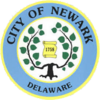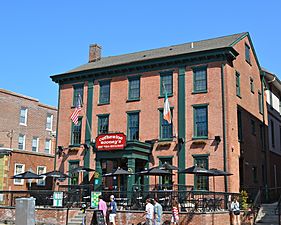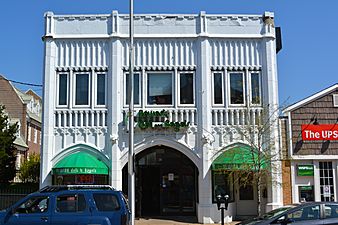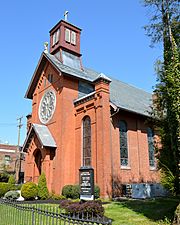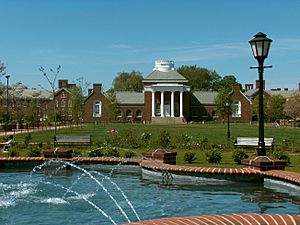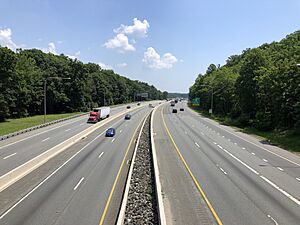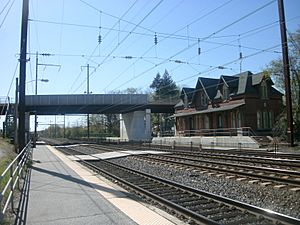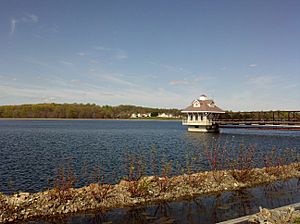Newark, Delaware facts for kids
Quick facts for kids
Newark, Delaware
|
|||
|---|---|---|---|
| City of Newark | |||

Main Street is the commercial heart of Newark. It is adjacent to the University of Delaware.
|
|||
|
|||
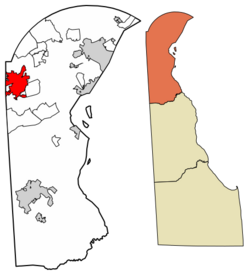
Location of Newark in New Castle County
|
|||
| Country | |||
| State | |||
| County | New Castle | ||
| Founded | 1694 | ||
| Incorporated | 1758 | ||
| Government | |||
| • Type | Council–manager | ||
| Area | |||
| • Total | 9.43 sq mi (24.42 km2) | ||
| • Land | 9.43 sq mi (24.42 km2) | ||
| • Water | 0.00 sq mi (0.00 km2) | ||
| Elevation | 128 ft (39 m) | ||
| Population
(2020)
|
|||
| • Total | 30,601 | ||
| • Density | 3,246.10/sq mi (1,253.27/km2) | ||
| Time zone | UTC-5 (Eastern (EST)) | ||
| • Summer (DST) | UTC-4 (EDT) | ||
| ZIP Codes |
19702, 19711-19718, 19725
|
||
| Area code | 302 | ||
| FIPS code | 10-50670 | ||
| GNIS feature ID | 214385 | ||
| Major highway | |||
| Commuter rail | |||
Newark (pronounced NEW-ark) is a city in New Castle County, Delaware, United States. It is about 12 miles (19 km) west-southwest of Wilmington. In 2010, the city had a population of 31,454 people. Newark is well-known as the home of the University of Delaware. The city is also part of the larger Philadelphia area, known as the Delaware Valley.
Contents
Newark's Rich History
Newark was first settled by people from Scotland and Ireland, along with Welsh settlers, in 1694. The town officially became a city when it received a special document, called a charter, from King George II of Great Britain in 1758.
Early Schools and Famous Students
Schools have always been important in Newark. A grammar school started by Francis Alison in 1743 moved to Newark in 1765. It was then called the Newark Academy. Some of its first students later became very famous. They included George Read, Thomas McKean, and James Smith. These three men signed the Declaration of Independence. Two schools in Delaware are named after George Read and Thomas McKean today.
The American Revolutionary War
During the American Revolutionary War, a battle happened near Newark. It was called the Battle of Cooch’s Bridge. People say that this battle was the first time the Stars and Stripes flag was flown in a fight.
The University of Delaware's Beginnings
In 1833, a new school called Newark College was given a charter by the state. The next year, Newark Academy and Newark College joined together. They became Delaware College. The school had to close in 1859 but reopened 11 years later. It became a joint project between the State of Delaware and the school's leaders. In 1913, the State of Delaware took full ownership. The school was renamed the University of Delaware in 1921.
Newark's Early Industries and Growth
In 1758, King George II allowed Newark to hold fairs twice a year and weekly markets. This helped farmers trade their goods. Around 1798, a paper mill was built. This was Newark's first big factory. It was later known as the Curtis Paper Mill. It was the oldest paper mill in the United States until it closed in 1997. The first church was built by Methodists in 1812. The railroad arrived in 1837, which helped the town grow.
The Chrysler Plant's Impact
For many years, the Chrysler Newark Assembly plant was a major employer in Newark. It was built in 1951. The famous reggae musician Bob Marley even worked there for a short time in the 1960s. The plant was very large and provided many jobs. It closed in late 2008 due to economic challenges.
Exploring Newark's Geography
Newark is located at 39.6837226 degrees north and -75.7496572 degrees west. It is just east of the Maryland state line. It is also less than a mile south of where Delaware, Maryland, and Pennsylvania meet. This spot is known as the Twelve-Mile Circle.
The city covers about 8.9 square miles (23 km2) of land. Newark used to be surrounded by farms. Now, there are many housing developments around it. However, farmland can still be found just across the state lines in Maryland and Pennsylvania. To the north and west, there are small hills. To the south and east, the land is flat.
Parks and Natural Areas
Even though Newark is between big cities like Philadelphia and Baltimore, it has lots of public parkland. There are over 12,000 acres (49 km2) of parks around the city.
- To the south is Iron Hill Park.
- To the west is Fair Hill Natural Resources Management Area in Maryland.
- To the north are White Clay Creek State Park and White Clay Creek Preserve in Pennsylvania.
- Middle Run Valley Natural Area is also nearby.
These parks offer great places for hiking, mountain biking, and horseback riding. Much of this land used to belong to the Du Pont family. They later gave it to the states of Maryland and Delaware.
Newark's Population and People
| Historical population | |||
|---|---|---|---|
| Census | Pop. | %± | |
| 1860 | 787 | — | |
| 1870 | 915 | 16.3% | |
| 1880 | 1,148 | 25.5% | |
| 1890 | 1,191 | 3.7% | |
| 1900 | 1,213 | 1.8% | |
| 1910 | 1,913 | 57.7% | |
| 1920 | 2,183 | 14.1% | |
| 1930 | 3,899 | 78.6% | |
| 1940 | 4,502 | 15.5% | |
| 1950 | 6,731 | 49.5% | |
| 1960 | 11,404 | 69.4% | |
| 1970 | 21,298 | 86.8% | |
| 1980 | 25,247 | 18.5% | |
| 1990 | 25,098 | −0.6% | |
| 2000 | 28,547 | 13.7% | |
| 2010 | 31,454 | 10.2% | |
| 2020 | 30,601 | −2.7% | |
| U.S. Decennial Census | |||
| Census Year | 2021 ACS |
|---|---|
| White | 68.2% |
| Black | 8.5% |
| Asian | 7.8% |
| Hispanic or Latino | 11.1% |
| 2 or More | 3.7% |
In 2000, there were 28,547 people living in Newark. The population density was about 3,198 people per square mile (1,235 people per km2). The city's population included people from many different backgrounds. About 87% were White, 6% Black, and 4% Asian. About 2.5% of the population was Hispanic or Latino.
The median age in Newark was 23 years old. This is because many students from the University of Delaware live in the city.
Education in Newark
Newark has a strong focus on education, from public schools to a major university.
Public Schools for Young Learners
Public schools in Newark are run by the Christina School District. This district also serves parts of Wilmington. There are several elementary schools (Kindergarten to 5th grade) within the city limits:
- Downes Elementary School
- Maclary Elementary School
- McVey Elementary School
- West Park Place Elementary School
- Brookside Elementary School (in nearby Brookside)
Other schools with a Newark address include Gallaher Elementary School and Jennie E. Smith Elementary School. Most middle school students attend Shue/Medill Middle School.
High Schools in the Area
Most high school students in Newark go to Newark High School. Some parts of the city are zoned for Glasgow High School. The Delaware School for the Deaf (K-12) is also located nearby in Brookside. Newark Charter School is another option, offering grades K-12.
The University of Delaware Campus
Newark is home to the University of Delaware (UD). This university offers many different study programs. It is especially known for its programs in business, chemical engineering, chemistry, and biochemistry. These programs are strong because of the history of chemical and pharmaceutical companies in Delaware. Main Street in Newark is a popular spot for both university students and residents. It has many restaurants and unique shops.
Sports and Recreation
Newark is a well-known place for figure skating. Many national, world, and Olympic champions have trained at the University of Delaware Figure Skating Club.
University Sports Teams
The University of Delaware has 21 different sports teams. They compete in NCAA Division I. The teams are called the Fightin' Blue Hens. This name comes from the Blue Hen of Delaware, which is the state bird. The university's mascot is named YouDee.
Professional Basketball in Newark
The Delaware 87ers were a professional basketball team. They played in the NBA G League and were connected to the Philadelphia 76ers. From 2013 to 2018, they played their home games at the Bob Carpenter Center on the University of Delaware campus. They later moved to Wilmington and changed their name to the Delaware Blue Coats.
Getting Around Newark
Newark has a good transportation system, making it easy to travel in and out of the city.
Roads and Highways
Several major roads go through the Newark area. Interstate 95 is a main highway that passes south of Newark. Delaware Route 896 is a key north-south road that goes through the city. Other important roads include Delaware Route 273, Delaware Route 2, Delaware Route 4, and Delaware Route 279.
The City of Newark manages parking in the downtown area. There are parking meters and several parking lots available. The University of Delaware also has its own parking areas on campus.
The closest airport for flights is Wilmington Airport. For more flights, including international ones, people use Philadelphia International Airport.
Train and Bus Services
Newark has a train station south of downtown. It is used by SEPTA and Amtrak trains. SEPTA provides service during busy morning and evening hours on weekdays. Amtrak also has limited service to Newark.
Newark is also served by DART First State bus routes. These buses connect Newark to places like Wilmington, the Christiana Mall, and Middletown. The Newark Transit Hub is a central point for many bus routes. The University of Delaware also has its own free shuttle bus system for students and staff.
City Services and Utilities
The City of Newark provides important services to its residents. The City of Newark Electric Department supplies electricity to homes and businesses. They buy electricity and manage the city's power lines.
The City of Newark Public Works and Water Resources Department handles trash collection, recycling, water, and wastewater services. Water comes from the Newark Reservoir. The city also manages sewer lines, sending wastewater to a treatment facility in Wilmington. Natural gas service in Newark is provided by Delmarva Power.
Famous People from Newark
Many notable people have connections to Newark:
- Joe Biden (born 1942), who became the 46th President of the United States. He was also a U.S. Senator and Vice President.
- Tarzan Cooper (1907–1980), a professional basketball player.
- Harry Coover (1917–2011), an inventor.
- Joe Flacco, a former University of Delaware football player and NFL quarterback.
- George Thorogood, a rock and roll musician.
- Johnny Weir, a U.S. figure skating champion.
Media in Newark
Newark has its own local media to keep residents informed.
Radio Station
- WVUD/91.3: This is the radio station for the University of Delaware.
Magazine
- Newark Life Magazine
Newspaper
- Newark Post
See also
 In Spanish: Newark (Delaware) para niños
In Spanish: Newark (Delaware) para niños



